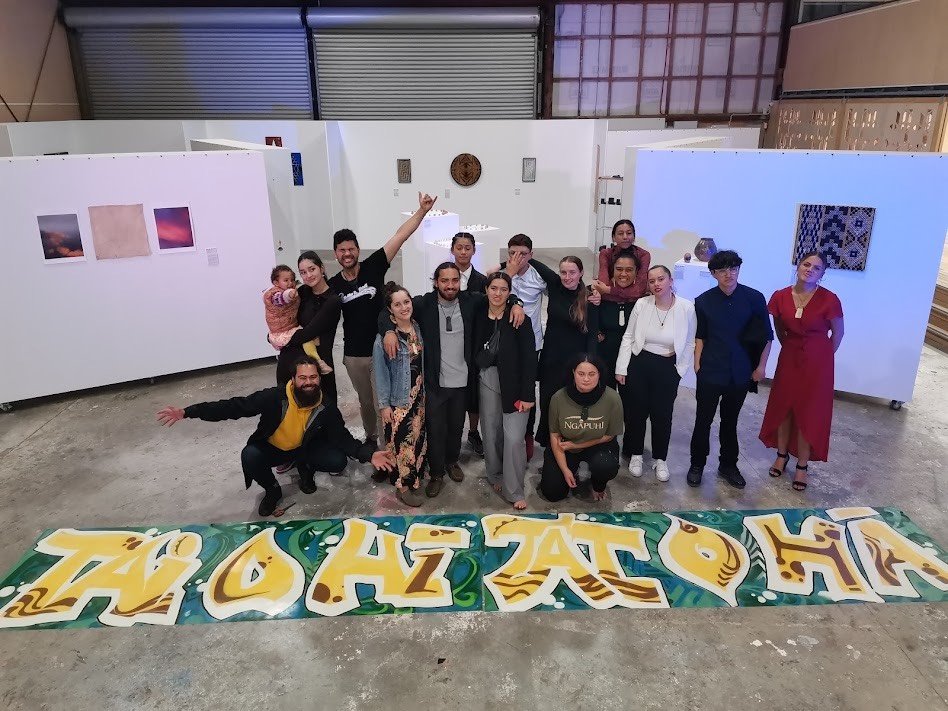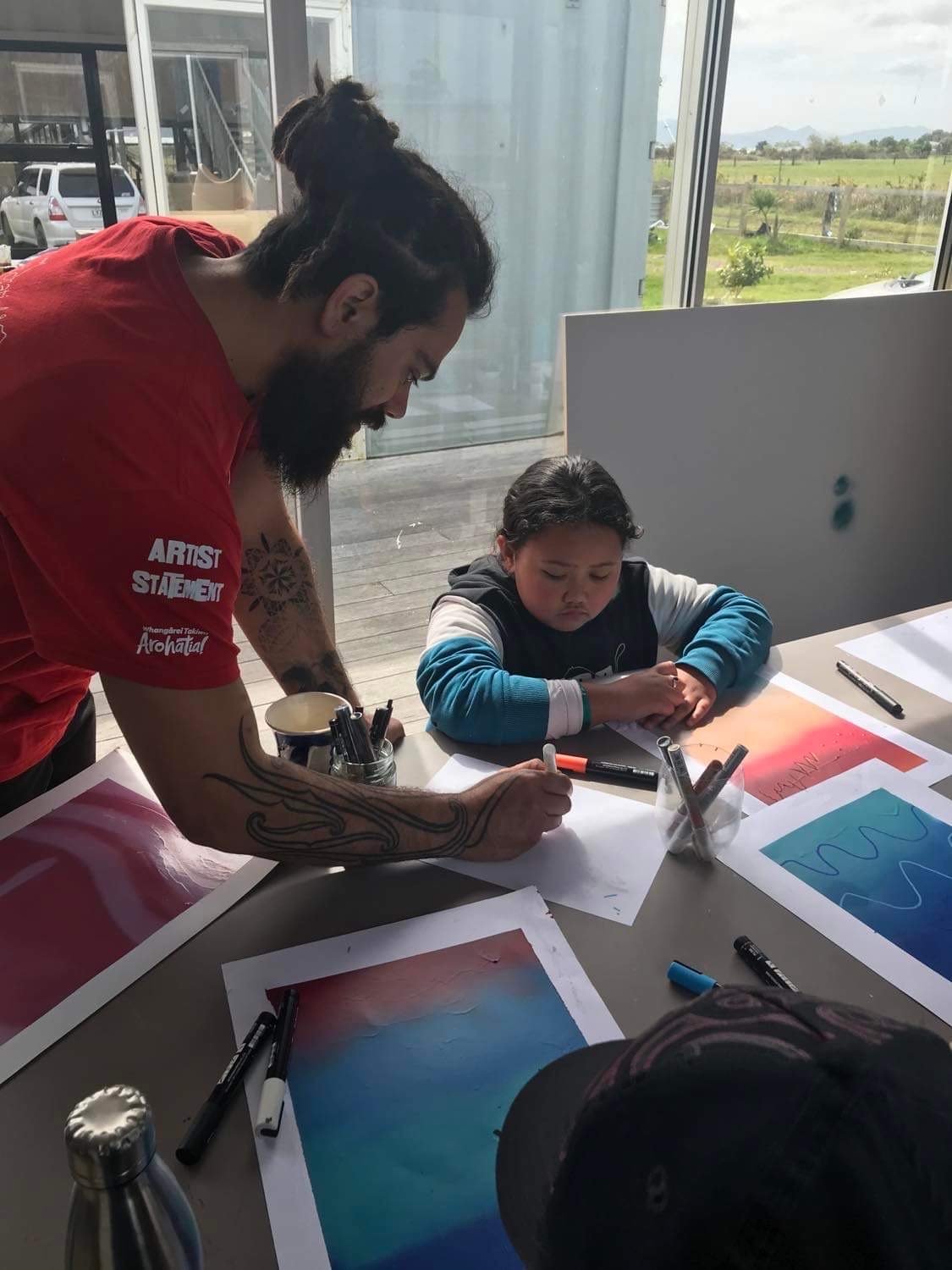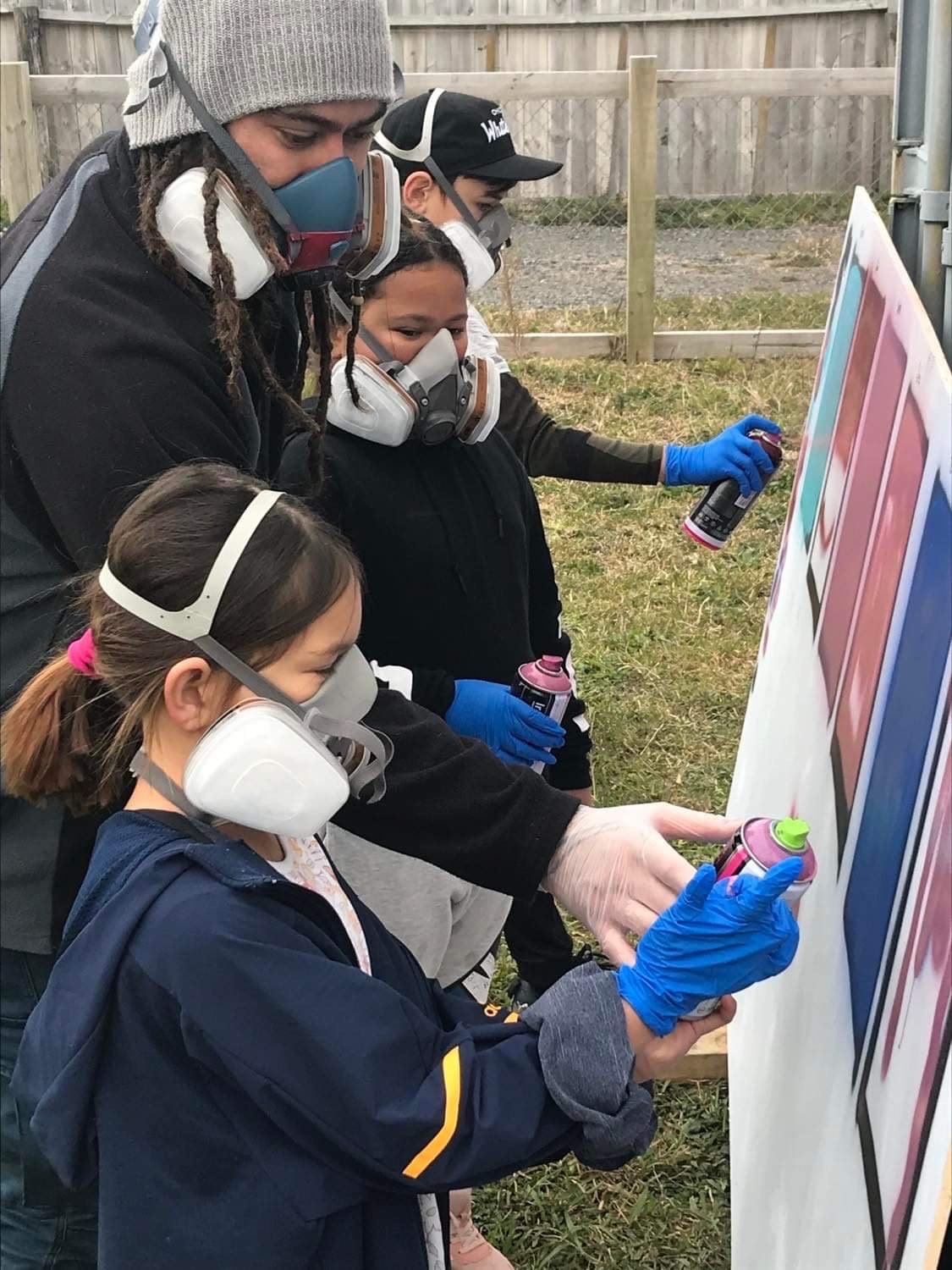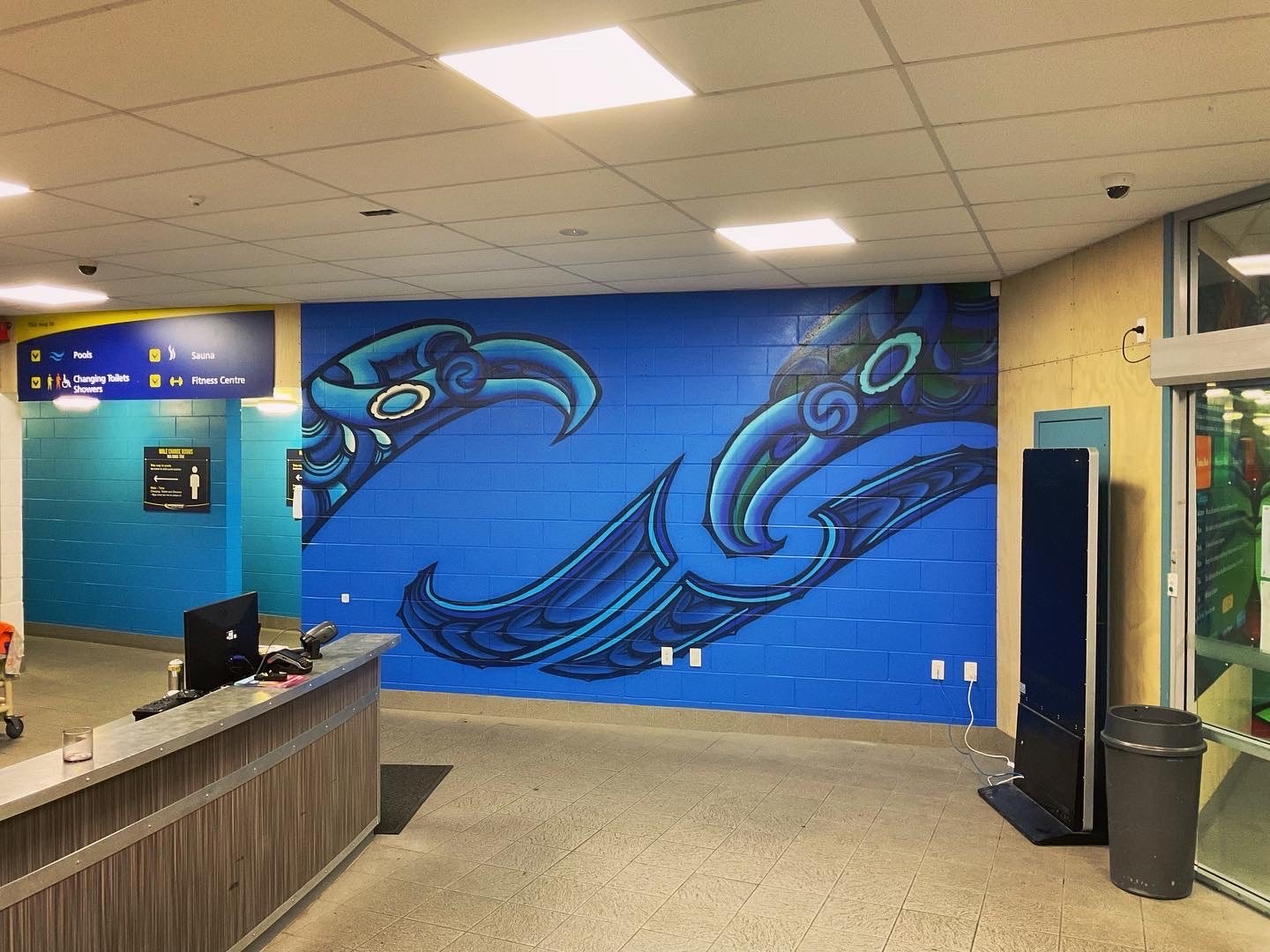MARINO DUKE
Live street art painting at Oho Whakarere in Raumanga. Oho whakarere was a kaupapa led by Ngāti Hine to promote the use of our Reo Māori. Photo Credit Erana Fenton, Ngāti Hine FM.
Wai Ora- Whangārei Aquatic Centre
Ko Waitī rāua ko Waitā- This mural is inspired from our pūrākau regarding Matariki.
Tai o Hī Tai o Hā exhibition at Hihiaua in Whangārei. Marino was a guest ringatoi at the third Tai o Hī Tai o Hā wānanga.
“He wants to utilise his skills for the next generation, and is willing to share his teachings with the younger generation which he says serves a soul purpose - it can live on into the next generation ”
FEATURED: Marino Duke - For the People
Ngāpuhi, Ngāti Wai
Ko Manaia te maunga
Ko Terenga Paraoa te moana
Ko Māhuhu-ki-te-rangi te waka
Ko Rangiora te whare
Ko Te Hopua te awa
Ko Te Ikanui te tangata
Ko Patuharakeke te hapū
Ko Ngāpuhi te iwi
Ko Davina Duke tōku māmā
Ko Marino tōku ingoa
Marino is a multi-disciplinary artist. He is a graffiti artist, muralist, and kaiwhakairo and has taken part in various graffiti, mural, and whakairo projects. He has also been trained in tāmoko and bone carving.
Marino explains that exploring toi Māori but with spray cans on walls is a groundbreaking space. This combination fuses traditional and modern Māori art. Marino relates to the kōrero that when Tane had received the kete of knowledge, Whiro sought Rehua for some adornments for his whare. He visited Rehua and Rehua gifted him the art of pigment and painting and goes on to say that painting doesn’t hold the same tapu as mahi whakairo and in that aspect, it’s a freer domain. Paint and pigment at their inception were always given more freedom. After Marino understood this kōrero, he felt more at peace to push his boundaries and delve into the world of Māori graffiti.
Marino grew up between Takahiwai and Whananaki and still lives between these two places- his two tūrangawaewae. His mother, Davina Duke, is an uku artist so toi is in his blood and he has been brought up around other Māori artists such as Manos Nathan. While enrolled at Kamo High School he was inspired and encouraged by his science teacher matua Caleb who had a passion for graffiti and would buy his students cans and open his classroom for them to practise their mahi toi. It was here that Marino’s drawing skills impressed a group of older boys at Kamo High and he was invited to join their crew On the Rise. Matua Caleb sowed the kākano and Marino says if it wasn’t for him Marino wouldn’t have found his love for graffiti.
After a year of Marino doing whakairo at Te Wananga o Aotearoa, he took a leap of faith and responded to Rangi Kipa’s karanga for an apprentice. Rangi Kipa (Māori artist from Waitara, Taranaki) was in Tutukaka and worked with Marino for four months, training him in tāmoko, bone carving, and whiri (plaiting). When Marino did his first taura plait, Rangi analysed it from beginning to end and told him to start again. He drilled into Marino an eye for detail and not to settle for anything less than excellence. Rangi set the taumata: Marino says that this excellence can only be obtained from repetitive practice, hour after hour, day after day. Even if Marino doesn’t practice these teachings for a long time, he is still able to pick it up again easily. Rangi left Tutukaka and assigned Marino 50 hei matau made out of Corian material to complete, a test for Marino to see if he could deliver. Upon completing these hei matau, Marino was then given the opportunity to carry on with Rangi who was moving south to Tauranga, where he continued to train under Rangi for almost a year before returning home to Te Tai Tokerau again.
Since this journey, Marino has completed mural, graffiti, and whakairo projects. One thing about Marino’s toi that sets him apart is that he doesn’t seek out his mahi; the opportunities arise naturally. Most of the time people seek him out for projects. Marino can draw upon the necessary people from his network of established relationships to help him with any projects he’s doing and sees this as a huge strength.
Marino is inspired by the mahi our old people have created and the excellence they have left behind. He wonders what impact the mahi that he does can have on our people. He wants to give back to the people with the practices that he has been trained in and believes that if we have the taonga and skills, they should be used. He also wants to utilise his skills for the next generation, and is willing to share his teachings with the younger generation which he says serves a soul purpose - it can live on into the next generation.
Marino being a multidisciplinary artist relates to the kōrero that Rangi Kipa shared with him that “once we understand the principles within one aspect of our toi those principles are universal throughout the different mediums”. Marino says that with bone carving and wood carving, the aesthetics, proportions, and dimensions are somewhat the same. It’s just the scale and medium that changes. Once you can grasp that understanding it's a lot easier to move into different mediums whilst maintaining the foundations and core principles.
Marino has recently done graffiti workshops with tamariki from Ruakākā Primary at his mum Davina’s studio in Takahiwai- The Uku Shack. In these workshops, the tamariki learnt the practical and functional things around creating a good piece of art. They had stencils to spray paint and created their own bombings, finishing the workshop with customised graffiti pieces. Ruakākā Primary is implementing localised history into the curriculum and thought these workshops would be a good way to tell these stories. From the kura’s perspective, to have someone from the local hapū to be able to offer this toi resource was beneficial for them, and for Marino, it was beneficial to be able to tell his hapū history through toi and graffiti. These workshops made toi Māori more attainable and accessible to these tamariki.
Marino completed a whakairo project for his hapū in 2020 which he says is the highlight of his career. The client for the whakairo project was NIWA fisheries. They had a new office in Ruakākā and approached Rangiora marae to see if there were any haukāinga kaiwhakairo and Marino was suggested by the marae kaumātua. This project was five weeks long and Marino’s bro Takarei Topine helped him carve and complete the taonga. The carving was taken back to the marae after it was completed and run past the kaumātua who didn’t want to let it go as they were so moved by it. This experience spoke to Marino of how important toi is. The kaumātua did a waerea early in the morning at NIWA to bless the whakairo piece. It blew Marino away to have the tautoko from both the kaumātua and his mum who was also really pleased with the mahi whakairo.
Pareparea, where Marino lives part-time, is on the coast of Whananaki and is his favourite place to create. He feels in tune there and says that the mahi just flows out. He likes creating on the whenua and close to the moana. Marino’s vision is to have space and resources for the masses to create toi on the whenua. He also envisages not having to outsource from the kāinga. If any whānau want a 21st key carved or a taonga, someone from the hapū will be able to make it. Marino wants to be able to offer those services for his whānau, and teach others as well. Marino would like taonga and toi Māori to be more accessible to Māori: his biggest drive is to see our people wearing our taonga and having access to them. He will be happy when he sees the nieces, nephews and kaumātua with the taonga.
The whakataukī that resonates with Marino is he tangata, he tangata, he tangata and he lives by tika, pono, and aroha. Marino has achieved a lot in his 28 years of life and hopes to complete more mahi whakairo for his iwi, graffiti workshops with other kura and various other projects with his kete of various skills and knowledge.
Written by Tai o Hī Tai o Hā Writing Intern Dina McLeod (Ngāti Wai, Ngāti Hine, Ngāpuhi).










